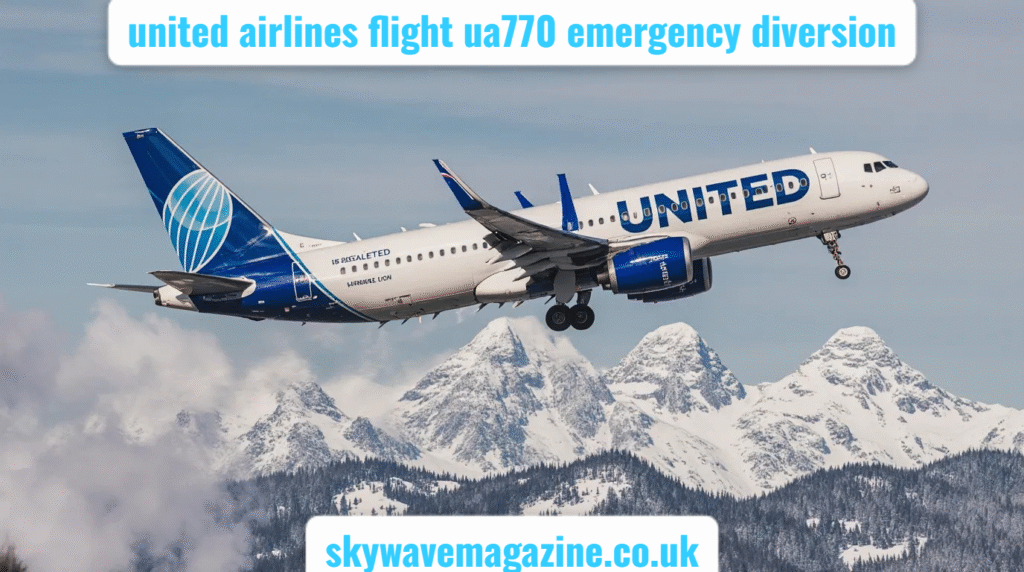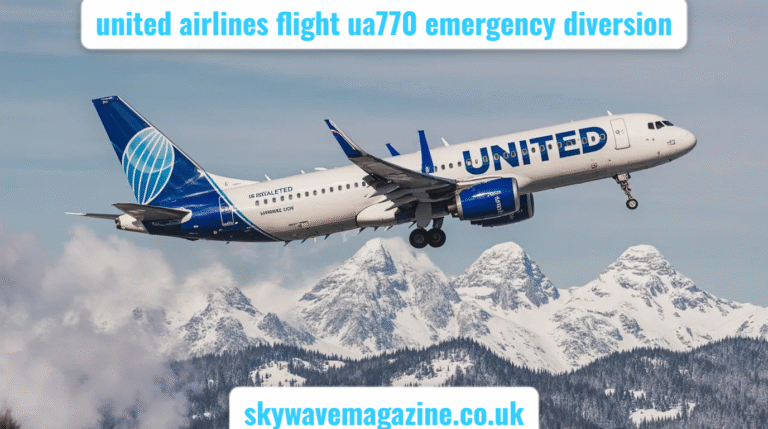
A Sudden Shift in the Skies: What Really Happened?
United Airlines Flight UA770, a standard commercial flight on its routine journey, became the center of attention after an unexpected and urgent diversion. On what was meant to be a seamless route, this flight made an emergency landing that sparked concern, speculation, and numerous passenger accounts across social media platforms. The sudden diversion was not just a minor detour—it reflected critical aviation protocols being executed under pressure. Whether you’re a frequent flyer, an aviation enthusiast, or just following the news, this article explores what really happened on UA770 and why such events are crucial learning points in airline safety management.
The Flight Details: Route, Aircraft, and Purpose
Flight UA770 was scheduled to fly from Los Angeles International Airport (LAX) to Chicago O’Hare International Airport (ORD) on a Boeing 737 aircraft. The flight carried around 160 passengers and crew members onboard. It was categorized as a routine domestic flight operated by United Airlines, one of the largest carriers in the United States. Scheduled to last approximately 4 hours, everything was progressing normally until the aircraft reached cruising altitude. According to data from flight tracking platforms, the aircraft suddenly deviated from its path, alerting the aviation community and triggering a rapid response.
The Mid-Air Anomaly That Triggered the Diversion
Roughly 90 minutes into the flight, the crew reported a technical malfunction that compromised the standard operation of onboard systems. Passengers onboard heard a loud mechanical noise followed by cabin lights flickering. Shortly afterward, the captain made an announcement stating the aircraft would be making an unscheduled landing. While details from official sources were initially limited, it was later revealed that a pressurization fault combined with an engine irregularity were behind the emergency call. Both issues, although individually manageable, posed a significant threat when occurring simultaneously.
Emergency Protocols and Crew Response
United Airlines’ response to the emergency diversion of UA770 followed the strict safety procedures outlined by the Federal Aviation Administration (FAA). The flight crew acted swiftly, communicating with Air Traffic Control and initiating emergency descent protocols. Oxygen masks did not deploy, which indicated the situation was under control, but tense. The cabin crew ensured passengers remained calm, seated, and buckled. The professionalism and composure displayed during the incident likely prevented panic, injuries, or worse. Every crew member adhered to practiced drills, demonstrating the vital importance of training in such scenarios.
The Diversion Airport: Emergency Landing in Denver
Denver International Airport (DEN) was selected as the diversion destination due to its strategic location and well-equipped emergency response facilities. The aircraft landed safely at DEN around 2:25 p.m. local time, escorted by emergency vehicles ready for immediate action. Passengers were instructed to remain seated until thorough technical checks were completed. While the emergency landing was successful and no injuries were reported, the airport briefly suspended other arrivals to prioritize the incoming aircraft. This swift adjustment by airport control underlines how seriously such diversions are taken.
Passengers’ Firsthand Accounts and Social Media Buzz
Social media became a hub for live updates as passengers onboard UA770 posted videos, photos, and commentary of their experience. Many praised the professionalism of the crew, though others admitted to being deeply shaken. Some described the flight as “the longest 20 minutes of their life,” referring to the descent into Denver. Platforms like Twitter and Reddit were flooded with hashtags like #UA770 and #UnitedAirlinesDiversion. These raw, real-time accounts added to the transparency surrounding the incident and also raised important discussions about in-flight safety and communication.
Official Statement by United Airlines
A few hours after the aircraft landed, United Airlines issued an official statement, acknowledging the emergency diversion and confirming that the crew acted according to established safety protocols. They emphasized that the safety of passengers and crew is their top priority and offered apologies for the inconvenience. The airline also provided meal vouchers and rebooking support to affected travelers. In their statement, they confirmed the incident involved a “mechanical irregularity” but did not specify further pending a full investigation.
FAA Investigation and Technical Evaluation
The FAA initiated an investigation into the emergency diversion of Flight UA770 to determine whether the event was a result of mechanical failure, procedural mishap, or manufacturer defect. Technicians from both United Airlines and Boeing were called to examine the aircraft’s engine systems, air pressure units, and flight data recorder. Preliminary findings suggest a malfunction in the cabin pressurization system, which required an immediate descent to ensure safety. The FAA’s final report is expected within a few weeks and will be publicly accessible upon completion.
Table: Timeline of Events for UA770 Diversion
| Time (Local) | Event Description |
| 11:45 AM | UA770 departs from LAX |
| 1:15 PM | Mid-air mechanical irregularity occurs |
| 1:20 PM | Flight crew initiates emergency procedures |
| 1:30 PM | Aircraft diverts course toward Denver |
| 2:25 PM | UA770 lands safely at Denver Airport (DEN) |
What Causes Pressurization Failures in Aircraft?
Cabin pressurization failures, although rare, are considered serious because they can rapidly compromise passenger health at cruising altitudes. Common causes include leaks in the fuselage, sensor failures, or malfunctioning outflow valves. If left unchecked, these problems can result in oxygen deprivation, a condition known as hypoxia, which is why immediate descent is mandatory. In the case of UA770, the swift detection and decision-making minimized potential damage and showcased the efficiency of onboard monitoring systems.
Aircraft Safety and Maintenance Compliance
United Airlines maintains a high standard of aircraft safety and maintenance. Their fleet, including the Boeing 737 involved in this incident, undergoes regular inspections, typically every 600 flight hours. While no airline can guarantee a problem-free journey, the robust layers of checks, from pre-flight inspections to mid-life overhauls, are designed to minimize risk. Incidents like UA770 remind the industry to continuously improve predictive maintenance and monitoring systems, especially with aging fleets and rising global air traffic.
Historical Context: Other Diversions by Major Airlines
UA770 is not the first commercial flight to be diverted for technical or safety reasons. Over the last decade, airlines including Delta, American Airlines, and even Emirates have had to make similar diversions. In 2023, for instance, a Delta flight diverted due to a smoke alarm in the cargo hold, which turned out to be a sensor fault. The aviation community closely studies such events to enhance real-time diagnostics, training programs, and emergency preparedness.
Passenger Compensation and Rights
In such cases, passengers often wonder what rights they hold. According to U.S. Department of Transportation (DOT) guidelines, airlines must offer alternative arrangements, including rerouting, accommodation (if required), and reimbursement depending on the delay duration. United Airlines provided rebooking and refreshment vouchers to passengers of UA770. However, no additional monetary compensation was issued as there were no injuries or violations of passenger rights.
Table: Passenger Entitlements Based on FAA Guidelines
| Situation | Airline Obligation |
| Flight Diversion | Reroute or refund, food & water |
| Extended Ground Delay (>3 hrs) | Allow deplaning or compensation |
| Safety Compromise (Injury/Medical) | Full investigation, liability coverage |
Industry Reactions and Expert Opinions
Aviation experts lauded the decision-making on UA770 as textbook-perfect. According to Captain Jeffrey H., a retired pilot with 35 years of experience, “The crew’s rapid response demonstrates why drills and simulations matter. Emergencies don’t give warnings, and every second counts.” Organizations like the Air Line Pilots Association (ALPA) and National Transportation Safety Board (NTSB) also praised the transparency shown by United Airlines, adding that such open communication improves public trust.
Lessons from UA770 for Airlines and Passengers
This incident serves as a learning opportunity for airlines to further invest in real-time diagnostics, crew training, and passenger communication. For travelers, it’s a reminder to always follow safety briefings, locate emergency exits, and report unusual behavior or sounds. Emergencies are rare in aviation, but preparedness—both operational and personal—is key to survival and resolution. United’s handling of the UA770 diversion underscores how aviation safety is more than compliance—it’s about constant vigilance.
Conclusion: A Safe Landing, A Valuable Reminder
The emergency diversion of United Airlines Flight UA770 may have caused momentary fear and logistical inconvenience, but it also reaffirmed how effective modern aviation systems and human response can be under pressure. From the crew’s quick thinking to the support offered by ground teams, everything worked as it should in a high-stakes environment. While investigations are still ongoing, the most important outcome is that everyone landed safely. Incidents like this shouldn’t create fear but rather inspire confidence in a system that prioritizes safety above all else.
Key Takeaways:
- UA770 diverted mid-flight due to a mechanical and pressurization issue.
- Emergency protocols were successfully followed by the crew.
- Flight landed safely at Denver International Airport.
- FAA and Boeing are investigating the malfunction.
- United Airlines provided support and rerouting to affected passengers.
Frequently Asked Questions (FAQs)
Q1: Was anyone injured during the UA770 emergency landing?
No injuries were reported. All passengers and crew landed safely and medical assistance was available at the airport.
Q2: Will the aircraft be returned to service?
That decision will be made after the FAA and Boeing complete their investigation and the aircraft passes all safety inspections.
Q3: Can passengers claim compensation for emergency diversions?
In the U.S., compensation is typically not mandatory for safety-related diversions, but airlines may offer support such as rebooking and vouchers.




